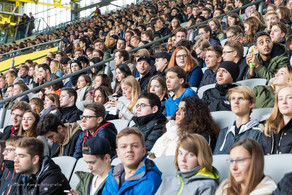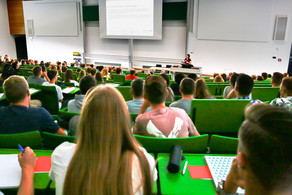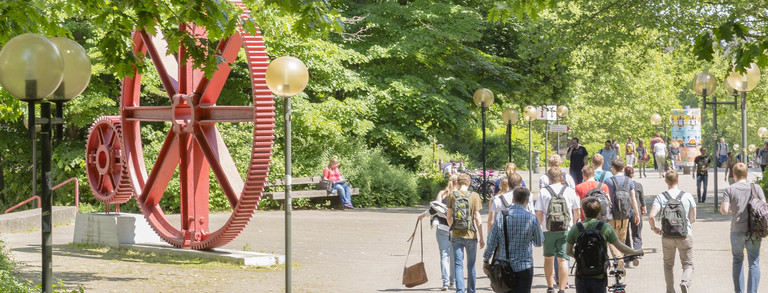Discussion papers SFB 823 in 2016
- 88/16: Svenja Fischer, Andreas Schumann, Alexander Schnurr
Ordinal pattern dependence between hydrological time series
- 87/16: Pramita Bagchi, Vaidotas Characiejus, Holger Dette
A simple test for white noise in functional time series
- 86/16: Nadja Bauer, Klaus Friedrichs, Claus Weihs
A multivariate approach for onset detection using supervised classification
- 85/16: Nadja Bauer, Klaus Friedrichs, Claus Weihs
Time efficient optimization of instance based problems with application to tone onset detection
- 84/16: James P. LeSage, Colin Vance, Yao-Yu Chih
A Bayesian heterogeneous coefficients spatial autoregressive panel data model of retail fuel duopoly pricing
- 83/16: Benedikt Gräler, Svenja Fischer, Andreas Schumann
Joint modeling of annual maximum precipitation across different duration levels
- 82/16: Carina Gerstenberger, Daniel Vogel, Martin Wendler
Tests for scale changes based on pairwise differences
- 81/16: Stefan Birr, Holger Dette, Marc Hallin, Tobias Kley, Stanislav Volgushev
On Wigner-Ville spectra and the unicity of time-varying quantile-based spectral densities
- 80/16: Martin Wagner, Achim Zeileis
Heterogeneity of regional growth in the EU: A recursive partitioning approach
- 79/16: Konstantin Eckle, Nicolai Bissantz, Holger Dette
Multiscale inference for multivariate deconvolution
- 78/16: Tobias Kley, Philip Preuß, Piotr Fryzlewicz
Predictive, finite-sample model choice for time series under stationarity and non-stationarity
- 77/16: Oliver Stypka, Peter Grabarczyk, Rafael Kawka, Martin Wagner
"Linear" fully modified OLS estmation of cointegrating polynomial regressions
- 76/16: Sergey Ivashchenko, Willi Mutschler
A note on functional equivalence between intertemporal and multisectoral investment adjustment costs
- 75/16: Martin Wagner, Peter Grabarczyk
The environmental Kuznets curve for carbon dioxide emissions: A seemingly unrelated cointegrating polynomial regressions approach
- 74/16: Manuel Frondel, Peter Grabarczyk, Martin Wagner
Integrated modified OLS estimation for cointegrating polynomial regressions - with an application to the environmental Kuznets curve for CO2 emissions
- 73/16: Fumiya Akashi, Holger Dette, Yan Liu
Change point detection in autoregressive models with no moment assumptions
- 72/16: Manuel Frondel, Peter Grabarczyk, Stephan Sommer, Martin Wagner
A cointegrating polynomial regression analysis of the material Kuznets curve hypothesis
- 71/16: Herold Dehling, Roland Fried, Max Wornowizki
An asymptotic test on the stationarity of the variance
- 70/16: Christine H. Müller, Stefan H. Meinke
Trimmed likelihood estimators for stochastic differential equations with an application to crack growth analysis from photos
- 69/16: Ekaterina Krymova, Anil Nagathil, Denis Belomestny, Rainer Martin
A new method for adaptive spectral complexity reduction of music signals
- 68/16: Daniel Horn, Bernd Bischl
Multi-objective parameter configuration of machine learning algorithms using model-based optimization
- 67/16: Annika Betken
Change point estimation based on the Wilcoxon test in the presence of long-range dependence
- 66/16: Annika Betken, Rafal Kulik
Testing for change in stochastic volatility with long range dependence
- 65/16: Klaus Friedrichs, Nadja Bauer, Rainer Martin, Claus Weihs
A computational study of auditory models in music recognition tasks for normal-hearing and hearing-impared listeners
- 64/16: Claus Weihs, Swetlana Herbrandt, Nadja Bauer, Klaus Friedrichs, Daniel Horn
Efficient global optimization: Motivation, variations and applications
- 63/16: Jona Lilienthal, Paul Kinsvater, Roland Fried
On the method of probability weighted moments in regional frequency analysis
- 62/16: Konstantin Eckle, Nicolai Bissantz, Holger Dette
Multiscale inference for multivariate deconvolution
- 61/16: Mark Andor, Andreas Gerster, Stephan Sommer
Consumer inattention, heuristic thinking and the role of energy labels
- 60/16: Tim Patschkowski, Angelika Rohde
Locally adaptive confidence bands
- 59/16: Holger Dette, Roman Guchenko, Viatcheslav Melas, Weng Kee Wong
Optimal discrimination designs for semi-parametric models
- 58/16: Holger Dette, Andrey Pepelyshev, Anatoly Zhigljavsky
Best linear unbiased estimators in continuous time regression models
- 57/16: Katharina Dyballa, Kornelius Kraft
The impact of disclosure obligations on executive compensation - A policy evaluation using quantile treatment estimators
- 56/16: Nicolai Bissantz, Justin Chown, Holger Dette
Regularization parameter selection in indirect regression by residual based bootstrap
- 55/16: Holger Dette, Vasyl Golosnoy, Janosch Kellermann
The effect of intraday periodicity on realized volatility measures
- 54/16: Manuel Frondel, Gerhard Kussel
Switching on electricity demand response: Evidence for German households
- 53/16: Marcel Brauer, Angelika Rohde
'Change in space'-point estimation, Part I: Lower bound for rates of consistency
- 52/16: Robert Löser, Dominik Wied, Daniel Ziggel
New backtests for unconditional coverage of the expected shortfall
- 51/16: Justin Chown
Efficient estimation of the error distribution function in heteroskedastic nonparametric regression with missing data
- 50/16: Justin Chown, Ursula U. Müller
Detecting heteroskedasticity in nonparametric regression using weighted empirical processes
- 49/16: Michael Hoffmann, Mathias Vetter, Holger Dette
Nonparametric inference of gradual changes in the jump behaviour of time-continuous processes
- 48/16: Willi Mutschler
Higher-order statistics for DSGE models
- 47/16: Betina Berghaus, Axel Bücher
Weak convergence of a pseudo maximum likelihood estimator for the extremal index
- 46/16: Denis Belomestny, Vladimir Panov, Jeannette H. C. Woerner
Low-frequency estimation of continuous-time moving average Lévy processes
- 44/16: Manuel Frondel, Colin Vance, Martin Wagner
Cycling on the extensive and intensive margin: The role of paths and prices
- 43/16: Max Wornowiziki, Roland Fried, Simos G. Meintanis
Fourier methods for analysing piecewise constant volatilities
- 42/16: Benedikt Funke, Masayuki Hirukawa
Nonparametric estimation and testing on discontinuity of positive supported densities: A kernel truncation approach
- 41/16: Maarten van Kampen
Nonparametric IV regression with an Archimedean dependence structure
- 40/16: Holger Dette, Josua Goesmann, Christian Greiff, Rebecca Janisch
Efficient sampling in materials simulation - exploring the parameter space of grain boundaries
- 39/16: Peter Behl, Holger Dette, Manuel Frondel, Colin Vance
A focused information criterion for quantile regression: Evidence for the rebound effect
- 38/16: Maria Konstantinou, Stefanie Biedermann, Alan Kimber
Model robust designs for survival trials
- 37/16: Matei Demetrescu, Dominik Wied
Residual-based inference on moment hypotheses, with an application to testing for constant correlation
- 36/16: Frank Bretz, Kathrin Möllenhoff, Holger Dette, Wei Liu, Matthias Trampisch
Assessing the similarity of dose response and target doses in two non-overlapping subgroups
- 35/16: Paul Kinsvater, Roland Fried
Conditional heavy-tail behavior with applications to precipitation and river flow extremes
- 34/16: Irina Roslyakova, Bo Sundmann, Holger Dette, Lijun Zhang, Ingo Steinbach
Modeling of Gibbs energies of pure elements down to 0K using segemented regression
- 33/16: Manuel Frondel, Michael Simora, Stephan Sommer
Risk perception of climate change: Empirical evidence for Germany
- 32/16: Aeneas Rooch, Ieva Zelo, Roland Fried
Estimation methods for the LRD parameter under a change in the mean
- 31/16: Mark A. Andor, Manuel Frondel, Colin Vance
Germany's Energiewende: A tale of increasing costs and decreasing willingness-to-pay
- 30/16: Belmiro P.M. Duarte, Weng Kee Wong, Holger Dette
Adaptive grid semidefinite programming for finding optimal designs
- 29/16: Walter Krämer, Holger Dette
Beyond inequality: A novel measure of skewness and its properties
- 28/16: Simone Hermann
BaPreStoPro: an R package for Bayesian prediction of stochastic processes
- 27/16: Simone Hermann
Bayesian prediction for stochastic processes
- 26/16: Roger J. Bowden, Peter N. Posch, Daniel Ullmann
Asymmetry and performance metrics for equity returns
- 25/16: Roger J. Bowden, Peter N. Posch, Daniel Ullmann
Dual disadvantage and dispersion dynamics for income distributions
- 24/16: Maria Konstantinou, Holger Dette
Bayesian D-optimal designs for error-in-variables models
- 23/16: Holger Dette, Christophe Ley, Francisco J. Rubio
Natural (non-)informative priors for skew-symmetric distributions
- 22/16: Axel Bücher, Felix Irresberger, Gregor N.F. Weiss
Testing asymmetry in dependence with copula-coskewness
- 21/16: Sermad Abbas, Roland Fried
Control charts for the mean based on robust two-sample tests
- 20/16: Manuel Frondel, Andreas Gerster, Colin Vance
The power of mandatory quality disclosure: Evidence from the German housing market
- 19/16: Jens Heinrich, Guido Heeke, Reinhard Maurer, Christine H. Müller
Resistance to fatigue and prediction of lifetime of wire tendons cast into concrete up to 108 cycles
- 18/16: Guido Heeke, Jens Heinrich, Reinhard Maurer, Christine Müller
Neue Erkenntnisse zur Ermüdungsfestigkeit und Prognose der Lebensdauer von einbetonierten Spannstählen bei sehr hohen Lastwechselzahlen
- 17/16: Sebastian Szugat, Jens Heinrich, Reinhard Maurer, Christine H. Müller
Prediction intervals for the failure time of prestressed concrete beams
- 16/16: Jona Lilienthal, Roland Fried, Andreas H. Schumann
Homogeneity testing for skewed and cross-correlated data in regional flood frequency analysis
- 15/16: Denis Belomestny, Egor Klochkov, Vladimir Spokoiny
Sieve maximum likelihood estimation in a semi-parametric regression model with errors in variables
- 14/16: Konstantin Eckle, Nicolai Bissantz, Holger Dette, Katharina Proksch, Sabrina Einecke
Multiscale inference for a multivariate density with applications to X-ray astronomy
- 13/16: Chrystel Feller, Kirsten Schorning, Holger Dette, Georgina Bermann, Björn Bornkamp
Optimal designs for dose response curves with common parameters
- 12/16: Walter Krämer
A neglected semi-stylized fact of daily stock returns
- 11/16: Swetlana Herbrandt, Uwe Ligges, Manuel Pinho Ferreira, Michael Kansteiner, Dirk Biermann, Wolfgang Tillmann, Claus Weihs
Model based optimization of a statistical simulation model for single diamond grinding
- 10/16: Holger Dette, Andrey Pepelyshev, Anatoly Zhigljavsky
Optimal designs for regression models with autoregressive errors structure
- 09/16: Ludger Linnemann, Gábor B. Uhrin, Martin Wagner
Government spending shocks and labor productivity
- 08/16: Walter Krämer, Simon Neumärker
Comparing default predictions in the rating industry for different sets of obligors
- 07/16: Mark Andor, Christopher Parmeter
Pseudolikelihood estimation of the stochastic frontier model
- 06/16: Simone Hermann, Fabrizio Ruggeri
Modelling wear degradation in cylinder liners
- 05/16: Holger Dette, Kirsten Schorning, Maria Konstantinou
Optimal designs for comparing regression models with correlated observations
- 04/16: Fabian Herrmann
Risk aversion, macro factors and non-fundamental components in Euro area yield spreads: A macro-financial analysis
- 03/16: Axel Bücher, Johan Segers
On the maximum likelihood estimator for the generalized extreme-value distribution
- 02/16: Manuel Frondel, Fernanda Martinez Flores, Colin Vance
Heterogeneous rebound effects: Comparing estimates from discrete-continuous models
- 01/16: Holger Dette, Katrin Kettelhake, Kirsten Schorning, Weng Kee Wong, Frank Bretz
Optimal designs for active controlled dose finding trials with efficacy-toxicity outcomes






